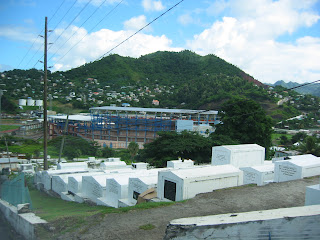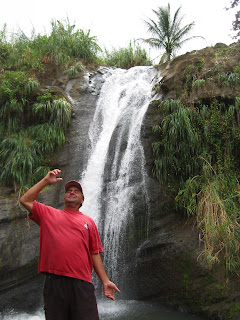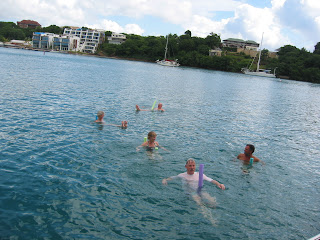(Gre-nay-da) is volcanic in origin, oval in shape and is only 133 square miles with a population of just over 100,000. The rich volcanic soil yields more spice per acre of land than anywhere else in the world. They grow cinnamon, vanilla, cloves, mace, ginger, cocoa with nutmeg being their number one industry along with exporting bananas,.
The National bird is the Grenada Dove.
The National bird is the Grenada Dove.
This Sorrel plant is boiled to make a refreshing fruity drink.
Cutty our tour guide makes regular stops along the way letting us feel, smell and taste a variety of fruits, spices and greenery. This is Ylang Ylang.
Traveling the mountainous terrain the road goes through the center of a cemetery.
Actually with all the rain the water was quite dirty.
 Cutty made regular stops along the way letting us feel, smell and taste a variety of fruits, spices and herbs. Here Cutty has a Golden Apple. You can eat this as an apple however it is very prickly inside and gets stuck in ones teeth. To me it tasted quite citrus. Cutty mentioned he normally makes wine with the Golden Apple.
Cutty made regular stops along the way letting us feel, smell and taste a variety of fruits, spices and herbs. Here Cutty has a Golden Apple. You can eat this as an apple however it is very prickly inside and gets stuck in ones teeth. To me it tasted quite citrus. Cutty mentioned he normally makes wine with the Golden Apple. Cutty also showed us the Sour Sop leaves which are used as a bug spray. He also explained how the Grenadian Saffron is in fact Turmeric which is very good for high blood pressure. Each time he stopped his van we wondered what he was going to share with us next. This time he introduces us to lemon grass.
Nutmegland was very interesting. Run by the Grenada Co-Operative Nutmeg Association Thomas is our guide today. Second to India in production of Nutmeg, Grenada produces a third of the world’s nutmeg.
The outside of the Nutmeg resembles a peach and is made into jams, jellies, and liquer. The shells are used like gravel lining driveways, walkways and we even saw them covering soil in planters.
Nutmegland was very interesting. Run by the Grenada Co-Operative Nutmeg Association Thomas is our guide today. Second to India in production of Nutmeg, Grenada produces a third of the world’s nutmeg.
The outside of the Nutmeg resembles a peach and is made into jams, jellies, and liquer. The shells are used like gravel lining driveways, walkways and we even saw them covering soil in planters.
 The next layer of the Nutmeg is the spice Mace. Mace sits on drying racks for four months. Thomas explained there is very strict quality control and mace is broken into three uses.. The first, highest quality being the darkest red is used for the spice itself. The second quality is a slightly lighter red used as a preservative and the third quality is yellow-orange in color and is used in perfumes and all cosmetics including lipsticks.
The next layer of the Nutmeg is the spice Mace. Mace sits on drying racks for four months. Thomas explained there is very strict quality control and mace is broken into three uses.. The first, highest quality being the darkest red is used for the spice itself. The second quality is a slightly lighter red used as a preservative and the third quality is yellow-orange in color and is used in perfumes and all cosmetics including lipsticks. The Nutmeg itself is dried on racks for 2 months using solar energy. There are only two qualities of Nutmeg.
The Nutmeg itself is dried on racks for 2 months using solar energy. There are only two qualities of Nutmeg.Usually women sit at these tables hand sorting thousands of nutmeg hourly. The Nutmeg that sinks is the first quality rich in oil and are the ones that go into making the spices that are used in our kitchens. The Nutmeg that floats is the second quality and is used in medicines. I have learnt nutmeg oil is used in cold ointments such as Vick's Vapour Rub.
Hurricane Ivan destroyed the majority of Grenada’s Nutmeg trees. To-day, four years later; the Nutmeg Co-operative is only running at 30% of its capacity with Nutmegland being the only plant open. The plant is running on 50% of it’s previous staff level. There are 3000 farmers supplying Nutmeg compared to almost 8000 farmers pre-Ivan.
The Nutmeg receives one last inspection prior to being put in sacks where any shells or broken shells are removed. To-day the #1 quality Nutmeg sells for $300.00 U.S. a sack.
I have read that nutmeg in fact has a narcotic effect when eaten in large quantities. It was so popular in the 18th Century, European upper class carried miniature silver graters wherever they went for those moments they needed a nutmeg "fix".
 Travelling along the west coast Cutty shows us “houses within houses”. After Hurricane Ivan people rebuilt their homes right on top or around the original.
Travelling along the west coast Cutty shows us “houses within houses”. After Hurricane Ivan people rebuilt their homes right on top or around the original. Reaching the northern end of the Island we enter the most historical parish, St. Patricks and Sauteurs (French for Leapers).
Reaching the northern end of the Island we enter the most historical parish, St. Patricks and Sauteurs (French for Leapers). In 1650 a French Expedition bought extensive land from the Caribs for a few beads and knives. Within a year the Caribs became hostile with their new neighbours. This brought on a military campaign. The last forty Indians chose to jump off these cliffs rather than live under French rule.
Another stop along the road and Cutty picks Black Sage Leaves. He explains one used three yellow leaves for one cup of tea or five leaves for two cups. (always use an odd number he says.) The tea will help purify your blood or he also states: "use one leaf to polish your teeth".
We start our Rivers Distillery Tour having a very nice lunch. The fruit drink Sorrel is offered. Cutty gives each glass a splash of Rum. We later will find out why only a splash….(95 proof). I had Barracuda and Rand had Chicken. The tasty potato salad is made with the vegetable Christophene. Then on to the Distillery which has 223 years of history.
Sugar cane is loaded onto this trough and then crushed by the wheel. The juice is filtered and then processed into syrup. White lime is added to the cane juice as a purifier to give the juice a good level of acidity.
The left over mulch is called “Baggus” and is used to fuel the boilers or recycled into the fields.
The fermentation Room has a very strong yeast smell. The syrup fermentation process takes eight days.
All types of wood are used to get the fire hot enough for this process
 Anything less than 75 proof goes back to the distillery. When the distillery is running 700 bottles of Royal Grenadian Rum is made.
Anything less than 75 proof goes back to the distillery. When the distillery is running 700 bottles of Royal Grenadian Rum is made.YIKES !!! Too strong for me. This truly is “fire water”. I cannot imagine anyone asking for a second "taste".
 On our way out of Grenville we came across this beautiful church. Grenville is the second largest town on Grenada. The tiles on many of the rooftops were in fact originally ballast out of the many ships that travelled to this area hundreds of years ago and replaced with spices. The stores in Grenville are primarily owned by Indians and Syrians. Today the streets are full of local vendors.
On our way out of Grenville we came across this beautiful church. Grenville is the second largest town on Grenada. The tiles on many of the rooftops were in fact originally ballast out of the many ships that travelled to this area hundreds of years ago and replaced with spices. The stores in Grenville are primarily owned by Indians and Syrians. Today the streets are full of local vendors.Starfruit
 Our last stop is the extinct volcano “Grand Etang Crater” which is a bottomless lake. The higher elevation, 1910 feet causes us to feel the dampness in the air. At this level Grenada receives one hundred and sixty inches of rain. It’s a nice change from the close heat and humidity at sea level. There is no time today for any hikes as we are running a bit late.
Our last stop is the extinct volcano “Grand Etang Crater” which is a bottomless lake. The higher elevation, 1910 feet causes us to feel the dampness in the air. At this level Grenada receives one hundred and sixty inches of rain. It’s a nice change from the close heat and humidity at sea level. There is no time today for any hikes as we are running a bit late.Look at the amazing caterpillars we found on one of the plants.
We are ready to leave and the monkeys show up to entertain us.
What a fun way to end a great full day.
What a fun way to end a great full day.































 Then we decided to take the local bus back to High States.
Then we decided to take the local bus back to High States.














